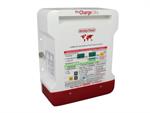outwestbound
Observer
Hello. Could you all help me understand which BRAND and/or 12V charger is better? I want to carry a good quality charger on international overland trips that I can occasionally plug into 110-240VAC, 50-60Hz shore power or power with my Honda 2000 generator in a pinch. I have no intention of plugging my shore power mains into any AC power source because of the risk of damage to my rig and I'll live off my batteries via my inverter. I have 260 total amp hours in my bank in the form of 2 6CRV260 6v AGM Crown batts in series, so 130Ah usable. Crown recommends 40 amps charge, so around 15.5%.
Because of undesirable interaction with my solar system, I want a programable charge profile so I can set the absorption point at 14.8 per the battery manufacturer, temperature sensor on the battery post and the ability to ramp the power down from 40amps (ie 75%, 50%, etc.) in case I get a marginal or inadequate AC power source, etc. Both of these have this.
I'm down to these two brand and model dry mount, 12V, 40amp, vented chargers. They appear identical to me (even same case) and are comparably priced. Could you all help select which one to get and why? Thanks
ProMariner ProNautic 1240P
Sterling Power- ProCharge Ultra - 12 Volt, 40 Amp Marine Battery Charger

Because of undesirable interaction with my solar system, I want a programable charge profile so I can set the absorption point at 14.8 per the battery manufacturer, temperature sensor on the battery post and the ability to ramp the power down from 40amps (ie 75%, 50%, etc.) in case I get a marginal or inadequate AC power source, etc. Both of these have this.
I'm down to these two brand and model dry mount, 12V, 40amp, vented chargers. They appear identical to me (even same case) and are comparably priced. Could you all help select which one to get and why? Thanks
ProMariner ProNautic 1240P
ProNautic 1240P
Industry recognized with the 2010 IBEX Innovation Award, ProNauticP employs our Generation 3 ProMar Digital Performance Charging Platform which combines all digital control and softwarebased power conversion technology with global energy management features. ProNauticP addresses the trend of...
www.promariner.com
Sterling Power- ProCharge Ultra - 12 Volt, 40 Amp Marine Battery Charger

Marine Battery Charger - Power Factor Controled (PFC) ProCharge Ultra- PCU
The new Sterling ProCharge Ultra. The Ultimate Marine Grade Battery charger. Delivers great performance, features and value.
www.sterling-power-usa.com
